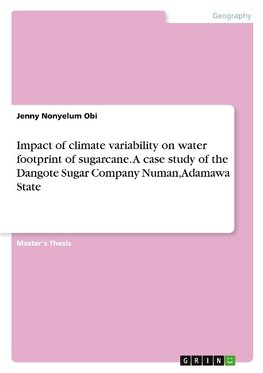
-
 Anglický jazyk
Anglický jazyk
Impact of climate variability on water footprint of sugarcane. A case study of the Dangote Sugar Company Numan, Adamawa State
Autor: Jenny Nonyelum Obi
Master's Thesis from the year 2016 in the subject Geography / Earth Science - Meteorology, Aeronomy, Climatology, grade: 4.53/5, Modibbo Adama University of Technology, Yola, course: Geography Climatology, language: English, abstract: This study is aimed... Viac o knihe
Na objednávku
44.37 €
bežná cena: 49.30 €
O knihe
Master's Thesis from the year 2016 in the subject Geography / Earth Science - Meteorology, Aeronomy, Climatology, grade: 4.53/5, Modibbo Adama University of Technology, Yola, course: Geography Climatology, language: English, abstract: This study is aimed at analysing the impact of climate variation on water footprint of Sugarcane using the sugarcane estate of the Dangote Sugar Company as a case study. Within this framework, the study's specific objectives are the following. To determine the green and blue water footprint of sugarcane production. To assess the contribution of the individual climatic parameters to each of green and blue water footprint of sugarcane. To examine the relationship between climatic elements and overall water footprint pattern of Sugarcane.
There is an anticipation of a restructuring of the patterns of demand and supply of water for agriculture owing to possible effects of change in climate. Thus, the assessment of the influences of climatic variation on water consumption for agriculture is of import. Water footprint as an indicator provides a different methodology to the assessment of agricultural water consumption under variability of climate. This study offers an analysis of the impact of climate variability on the water footprint of sugarcane in Dangote Sugar Company, Numan during 1981-2013. Climate data was collected for a period of 33 years. Using the CROPWAT model, water footprint for sugarcane was calculated. The outcome was later correlated using the SPSS and SPSS AMOS 21 packages to find the relationship between water footprint of sugarcane and the climatic variation. Also the impact climatic variables had on water footprint of sugarcane was deduced. The results indicated that a) crop evapotranspiration and irrigation water requirements of sugarcane in the study area presented an uptrend and this is due to the variation in climatic factors; b) green water footprint (102 m3/ton) was lower than the blue water footprint (172 m3/ton) and; c) the climatic factors accountable for 17% of the variation in water footprint of sugarcane under the study period. From the results, it was observed that water footprint of sugarcane is influenced most by the rainfall element. However, there are other agricultural management factors that may also have an effect on it, even higher than that of climate. Attention however must be given for adaptation of effective strategies to reduce the agricultural production risk associatedwith climate change in the long run.
- Vydavateľstvo: GRIN Verlag
- Rok vydania: 2021
- Formát: Paperback
- Rozmer: 210 x 148 mm
- Jazyk: Anglický jazyk
- ISBN: 9783346303158




 Nemecký jazyk
Nemecký jazyk 







